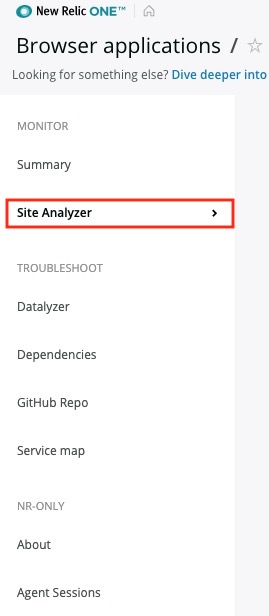You've probably heard the news by now: The New Relic One observability platform is programmable. As the central component of an observability platform, we believe programmability enables you to connect your observability data to your business, so you can make data-driven decisions—on your terms.
To that end, New Relic One gives you the same tools our own engineers use to build the curated experiences you know and love. With these tools, you can build and deploy custom applications on New Relic One that connect your observability data, gathered from myriad sources—including third-party open-source data—all in one place.
To show you the possibilities—and to inspire your own app creations—we worked with members of the New Relic community to build a handful of open source applications ... and then we kept going. In fact, new apps are coming in every day. And we hope to see New Relic customers keep these app contributions coming.
In this blog series, we’ll highlight some of he most popular contributed apps. And here's the best part: All of these apps are open source and ready to be deployed right now!
In this edition, we cover:
- Top
- Datalyzer
- Browser Analyze
- Cloud Optimize
Top
One of our most popular applications to date, the Top app brings the classic Unix command into New Relic One. Top is a simple process monitor that lets you inspect the CPU, I/O, and memory of all processes running on a host. Install this app today and eliminate the drudgery of SSHing into hosts to run top—get all those summary metrics right in New Relic One.
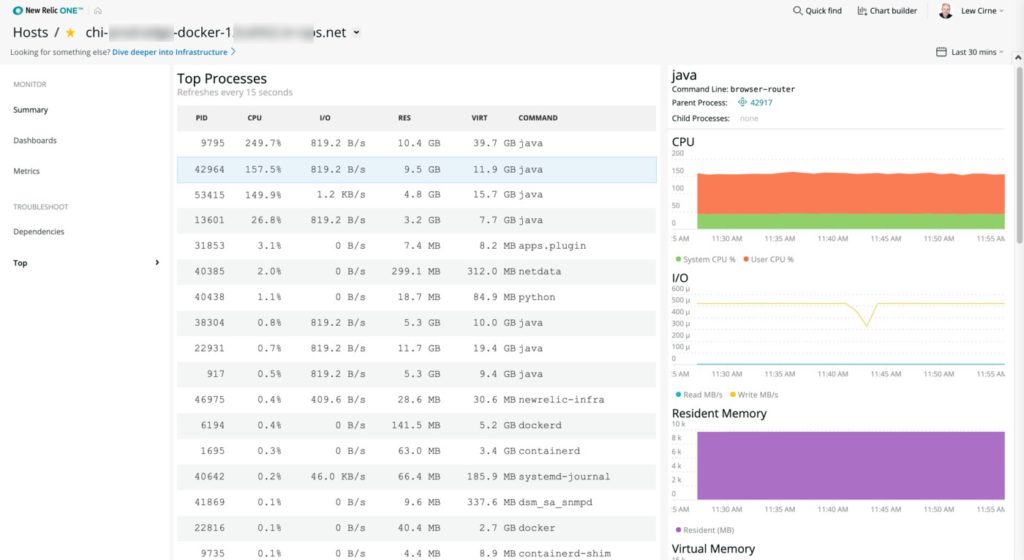
Fork or deploy the Top app from GitHub.
Specific requirements for this app
You’ll need the New Relic Infrastructure agent deployed on any host you want to monitor.
Datalyzer
The New Relic data platform collects and stores several key data types—metrics, events, traces, and logs (also referred to as M.E.L.T.)—from many different entities. But this data is highly dimensional and complex. Finding exactly what you’re looking for in a sea of data can be a challenge—especially if you’re not asking the right questions.
The Datalyzer app gives you an interactive view into all your data, so you can quickly slice and dice it with New Relic Query Language (NRQL) queries to answer questions, find the source of problems, and discover patterns you didn’t even know about. And from query to render time, it’s fast—lightning fast.
More specifically, Datalyzer allows you to:
- Search for any event or metric type
- See all dimensions and the frequency distribution of the attributes to identify commonality and outliers
- Click an attribute and get an immediate refresh of data faceted by that attribute
- Click a facet to automatically filter the view and repopulate the attributes with the new context
- See the NRQL query updated in real time
- Pin the chart to a dashboard or add to an alert
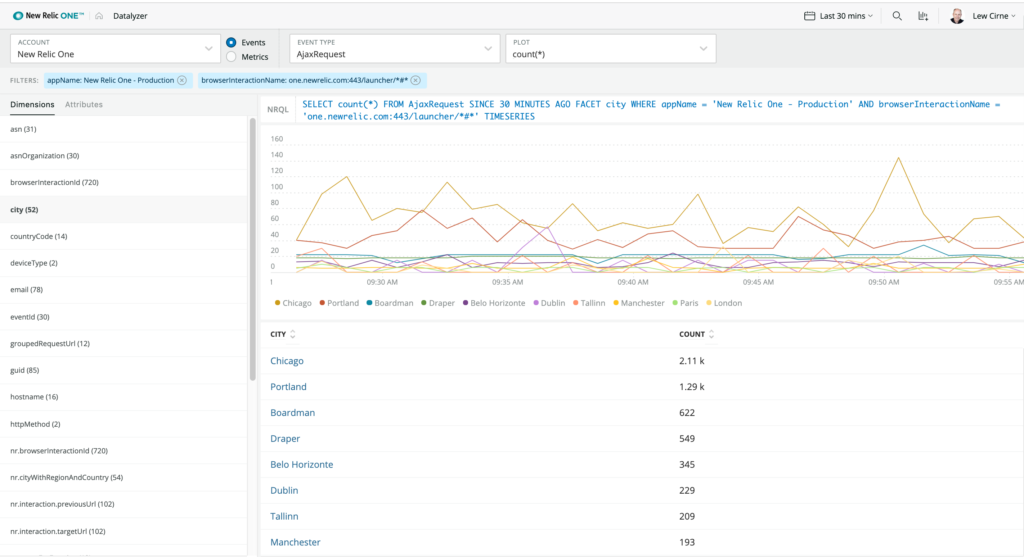
The Datalyzer app is offered as a launcher from the New Relic One homepage, providing global visibility across all accounts, metrics, and events. You can also access it from the entity explorer: select a service, mobile app, or browser app, and use the Datalyzer to analyze relevant data specific to that entity:
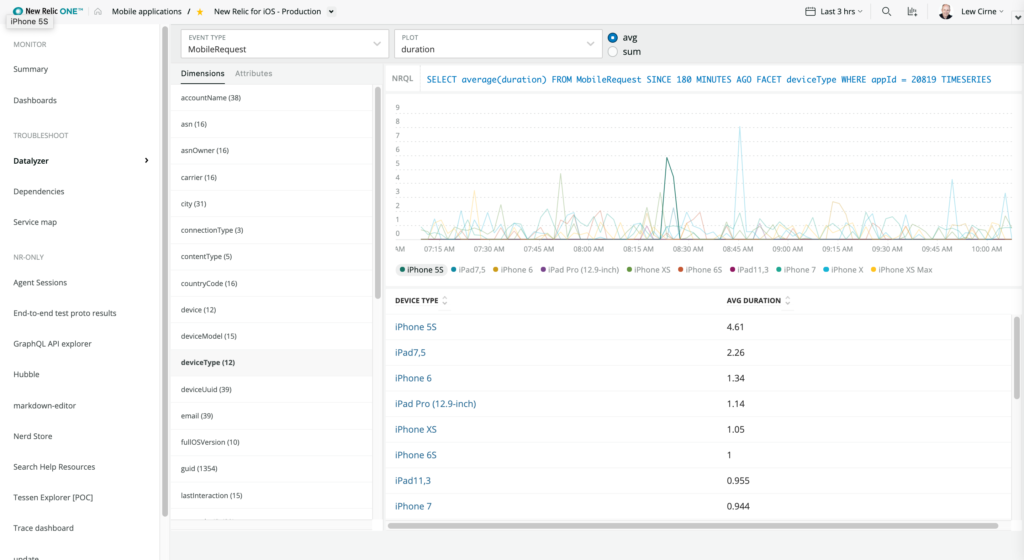
Fork or deploy the Datalyzer app from GitHub.
Specific requirements for this app
You’ll need a New Relic account with some data in it.
Note: When you query against metrics, Datalyzer allows you to explore dimensional metric data gathered by the Metric API. Part of our open instrumentation initiative, the Metric API sends detailed metric data to New Relic, without the need for an agent. Our Telemetry SDKs (and the open-source exporters that use them) also send this type of data. Datalyzer does not support traditional (non-dimensional) metrics collected by older New Relic products.
Browser Analyzer
One day, our General Manager for New Relic Browser, Buddy Brewer, envisioned a simple way to visualize customer experience and satisfaction scores. He sent me a sketch, and two days later we had a production-ready application that showed not just what the customer experience scores were, but what they should be.
The Browser Analyzer app lets you know how slow pages increase bounce rates and hurt your business. It shows you the exact impact and forecasts how improving the performance of your website can improve KPIs like bounce rate and traffic. The app also figures out which pages of your site have the worst impact on performance, so you know where to start making fixes. The analysis is based on your Browser Apdex score (pulled from the Browser PageView event).
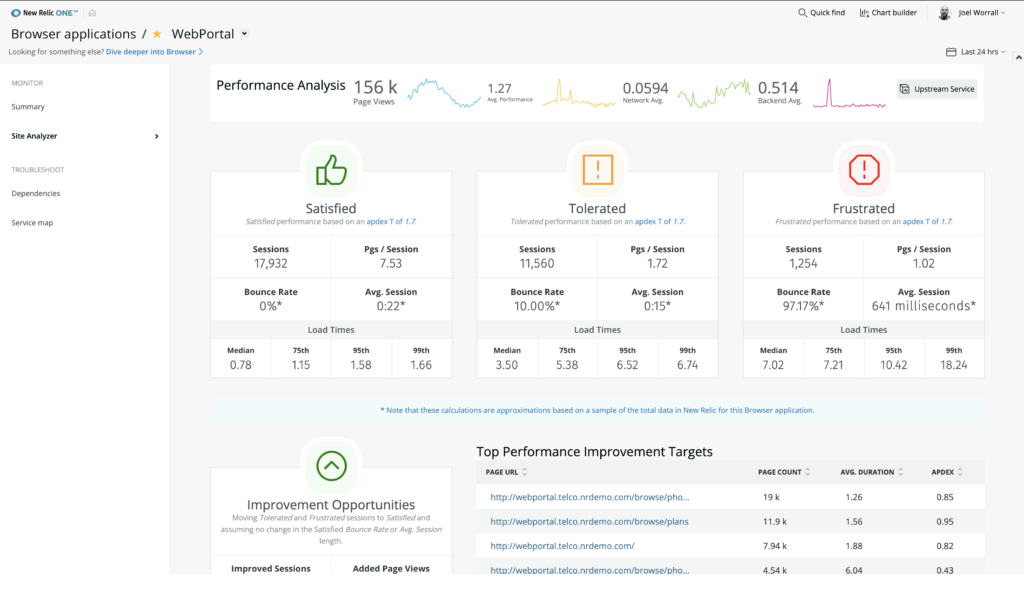
Note: This app is not served as a launcher on the homepage of New Relic One. Instead, you'll have to navigate to a Browser app via the entity explorer.
Fork or deploy the Browser Analyzer app from GitHub.
Specific requirements for this app
You’ll need to have New Relic Browser agents installed on the pages you want to monitor.
Cloud Optimize
For organizations that have made the great migration to the cloud, one question comes up time and again: “Are we wasting money on excess cloud capacity?” It can be difficult to connect the size and amount of infrastructure spending to the needs of your organization—especially if you operate at enterprise scale with dynamic, ephemeral resources.
But optimizing the size of your instances could save you thousands of dollars … or a lot more!
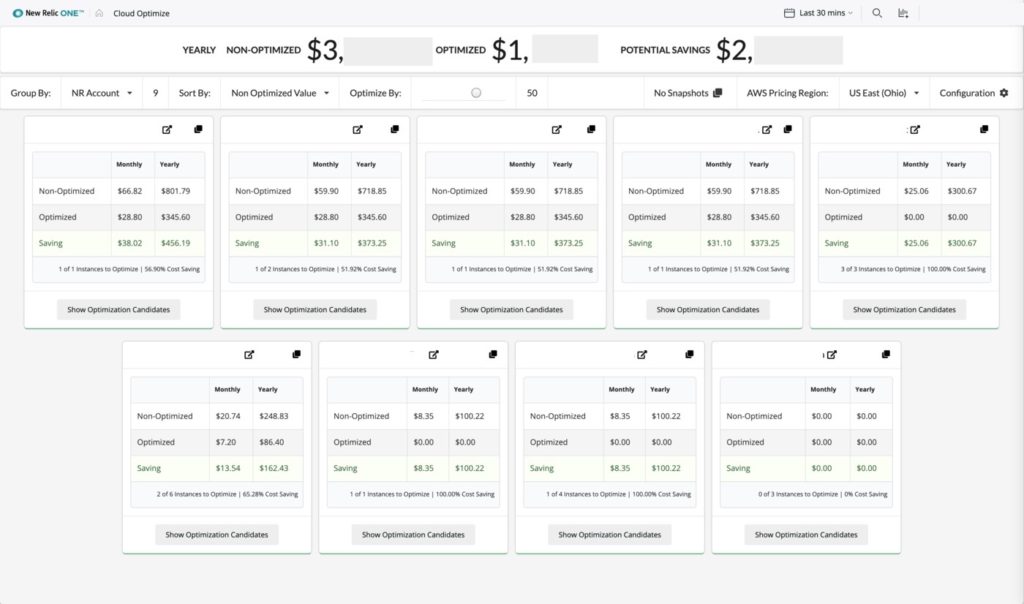
The Cloud Optimize app evaluates the size of your cloud instances and their utilization, and shows the amount of money you could save by right-sizing your instances while still delivering an excellent digital customer experience.
[embed]https://www.youtube.com/watch?v=qc4cHyPtylo&feature=youtu.be[/embed]
Specific requirements for this app
The Cloud Optimize app is compatible with Amazon Web Services (AWS), the Google Cloud, and the Microsoft Azure Cloud.
You’ll need to have New Relic Infrastructure agent(s) installed on your cloud computing devices.
To get the best possible data out of this application, we recommend that you install New Relic APM on applications hosted on your instances and group them by application. Then, depending on your cloud provider, choose one of the following:
- AWS: Activate the EC2 integration.
- GCP: Google Computer Engine integration.
- Azure: Azure VM’s integration.
What are you waiting for? Deploy these apps now!
To deploy any of these apps, you’ll need:
- Access to New Relic One (requires a paid New Relic account and use of a supported browser)
- The New Relic One CLI
- A personal New Relic API key
- Node v10 or higher
- A GitHub account
Once you have all these requirements in place, deploying an application locally—in this example, Browser Analyzer—is as easy as running a few commands:
nr1 nerdpack:clone -r https://github.com/newrelic/nr1-browser-analyzer.git cd nr1-browser-analyzer nr1 nerdpack:serve
Or you could download, configure, and deploy an account-specific instance of Browser Analyze to your New Relic account using the following commands:
nr1 nerdpack:clone -r https://github.com/newrelic/nr1-browser-analyzer cd nr1-browser-analyzer nr1 nerdpack:publish nr1 nerdpack:deploy -c STABLE nr1 nerdpack:subscribe -c STABLE
Then go to one.newrelic.com, click the entity explorer, select a browser app from the available list, and then click on your newly deployed Site Analyzer:
Check out these other resources for using—and building!—New Relic One applications
While we’d love you to use any of the applications we’ve built, we’ve created plenty of resources to help you get started creating your own New Relic One applications:
- newrelic.com Start building applications in minutes using our CLI and SDK. Review our library of React components for designing interfaces, charting data, and fetching data from our GraphQL API
- GraphQL Explorer: Explore your data using our GraphQL API
- New Relic documentation: Learn more about:
- The Nerdpack file structure, including how to link your application with an entity
- Application/data access and permissions and security
- NR1 Workshop: a step-by-step, self-paced, open source training experience, designed to introduce you to the New Relic One CLI and SDK
- New Relic Explorers Hub: Community posts and questions about using and building New Relic One applications
[embed]https://www.youtube.com/watch?v=FhEwaZuY81o[/embed]
Contribute to these open-source projects
We welcome contributions on any of our open-source applications. If you’d like to contribute, please review our Contributors Guide. Keep in mind that when you submit your pull request, you'll need to sign our CLA. If you'd like to execute our corporate CLA, or if you have any questions, please drop us an email at opensource@newrelic.com.
Be sure to check in as we preview more apps in future editions of this series.
The views expressed on this blog are those of the author and do not necessarily reflect the views of New Relic. Any solutions offered by the author are environment-specific and not part of the commercial solutions or support offered by New Relic. Please join us exclusively at the Explorers Hub (discuss.newrelic.com) for questions and support related to this blog post. This blog may contain links to content on third-party sites. By providing such links, New Relic does not adopt, guarantee, approve or endorse the information, views or products available on such sites.

